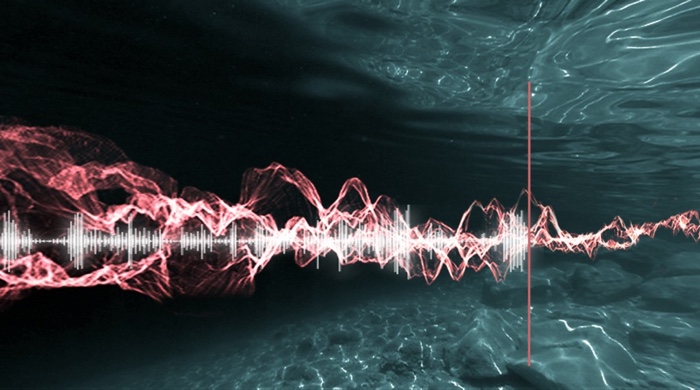
Robertina Šebjanič, Aquatocene / Subaquatic Quest for Serenity
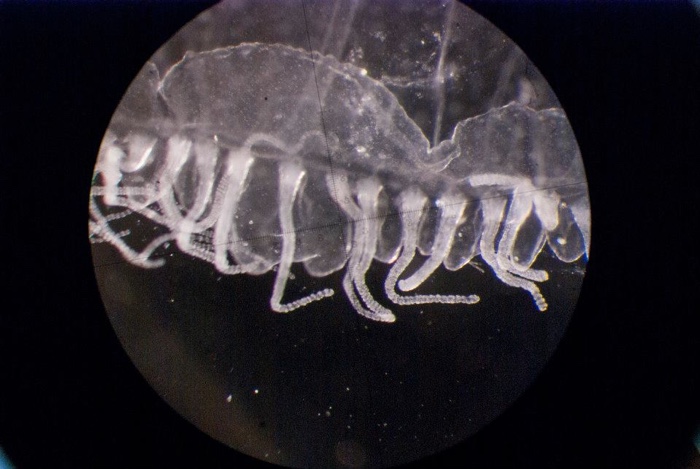
Deep Blue, field work and research at Institute of Marine science and technologies, Izmir, Turkey
Robertina Šebjanič is one of those rare artists who brings as much attention to the aesthetics and concepts behind her artworks as to the meticulous scientific research that sustains them.
Her installations, sound experiments and performances invite us to reflect upon our relationship as human beings with the rest of the world. Over the past few years, she has been collaborating with scientists, hackers, thinkers and other artists to explore themes such as interspecies communication, underwater sound pollution, the possible coexistence of animals and machines, chemical processes, the origin of life, etc.
Summing up her portfolio, awards and activities would be a lengthy affair so i’ll just highlight some of her latest achievements…
In 2012, Šebjanič organized Interactivos?’12 Ljubljana: Obsolete Technologies of the Future at LJUDMILA digital media lab where she was programme manager before leaving to work as a mission and programme developer at KSEVT – Cultural Centre of European Space Technologies (a role she kept until July 2014.)
Robertina is member of Theremidi orchestra and Hackteria Network. She’s also one of this year’s SHAPE Platform artists.
Robertina has been performing, developing, presenting and exhibiting her work all over the world over the past few years. I interviewed her just as she was back from a micro residency at Siva Zona / gray) (area on the Korcula island in the Adriatic and preparing for a residency at Arte+Ciencia at UNAM in Mexico. But before you read any further, please listen to the album that accompanies her project Aquatocene – Subaquatic Quest for Serenity. It’s an otherworldly and moving introduction to her research into the underwater soundscape.
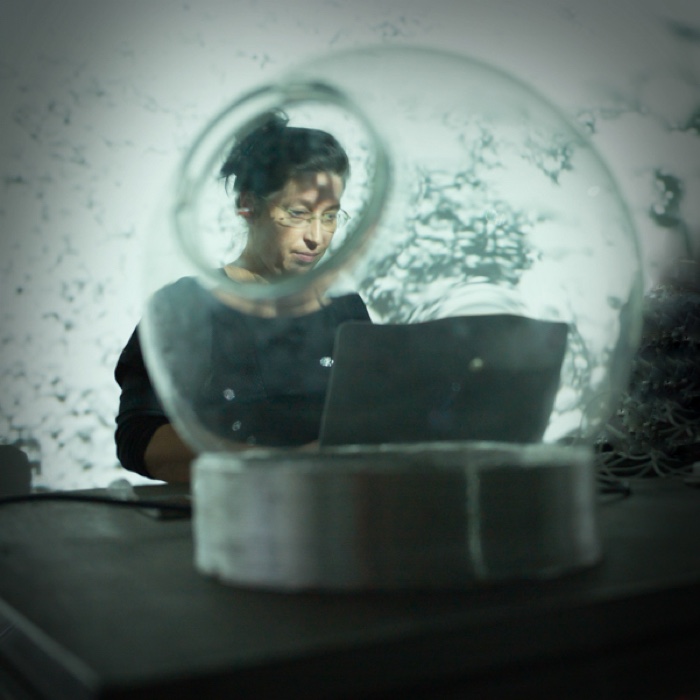
Robertina Šebjanič. Portrait by Bostjan Lah
Hi Robertina! The Aquatocene – Subaquatic Quest for Serenity project features underwater sounds of the ocean that you recorded using a hydrophone across different seas. First of all, that sounds like an amazing adventure. Which seas have you visited and how different are the sounds from one place to another? To most of us, the sea seems to be a mysterious, silent place so how loud are the sounds you recorded?
I have spent a lot of time in the Mediterranean, the Adriatic, the North Sea, and the Atlantic, and I have always brought my hydrophones with me. The dive into the underwater sonic environment really surprised me. For most people being next to the sea, on the shore, triggers a sense of serenity, and it was the same with me; but that changed when I started to record underwater sounds. “The serenity” was suddenly strongly challenged because of vivid aural underwater scape. Sound is travelling across the water much faster, and also wider, than in the air, which is also one of the reasons why sound is the main communication tool for many species. The light is only on the very surface of the sea but in deeper areas the light disappears and gradually turns into darkness. The human sonic presence such as boats and sonars is extremely disturbing for animals when they navigate in the ocean: the invasive sounds mostly confuse them and overtake their communications space.
My interest for the underwater sound began during my residency in Izmir in 2014, where I tried to record sound of swarm of jellyfish in the bay of Izmir. At the beginning I was irritated by anthropogenic sounds which have been present in most of the recordings. But the more I recorded and listened to the material, the more I realised that these sounds are today’s sonic reality of the ocean and that there is not much places that are free of man-produced sounds. Around the shores, a presence of sound pollution, produced by artificial interventions, is very common and therefore the soundscapes are changing, as there is less and less marine life.
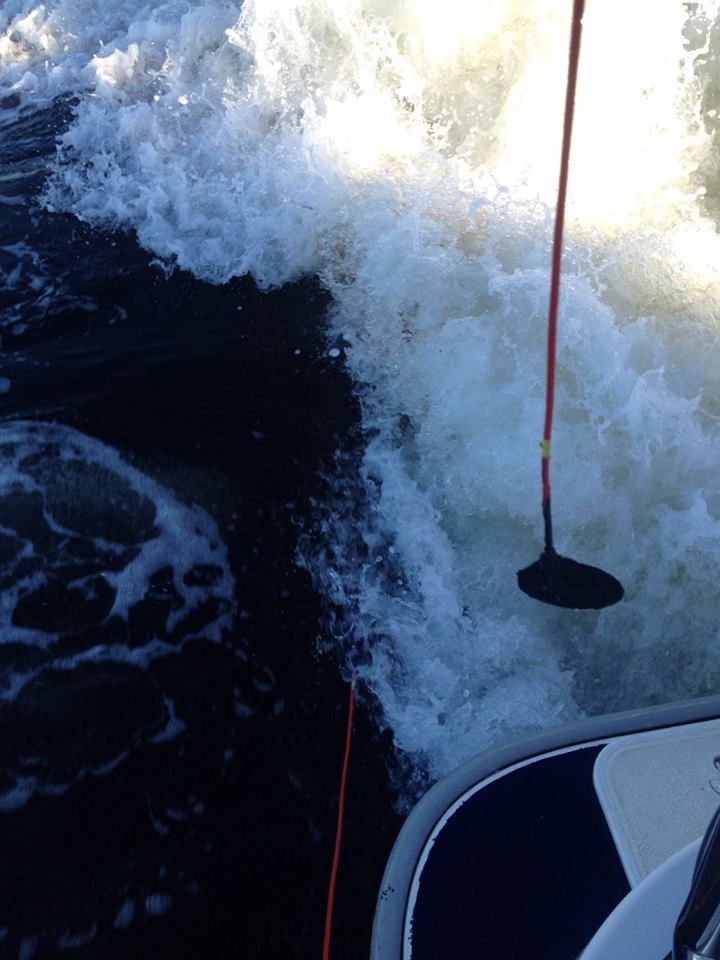
Field trip of hydrophone recording during the workshop Pikslo deep diving at Piksel festival, Bergen 2015
And what can you hear under the water? What kind of creatures and phenomena make noise down there?
The sounds of marine animals and their bioacoustics are amazing to explore and now I am already able to distinguish between different creatures and organisms.
Aquatic soundscape is very rich because it is full of sounds of mammals, fish and other sea organisms which communicate with and sometimes even sing to each other. For me, it is very interesting how different environments and ecosystems have different characters; so after getting familiar, these spaces become similar to city or forest.
During my recording sessions, I often come across some of the loudest animals in the sea such as shrimps (especially when they are in big numbers). For instance, I have been gathering sound recordings of shrimps in the fjords of Norway during the Pikslo workshop that I conducted together with my colleagues Slavko Glamočanin, Kat Austen and Gjino Šutić, which was part of the Piksel festival in Bergen. Furthermore, I have recorded sounds of sea urchins on the shores of Roscoff, France. I also have a lot of material from the Mediterranean sea with sounds of the swarms of jellyfish in Izmir, Turkey and the Adriatic sea: Dubrovnik, Croatia, Koper, Slovenia and latest recording of this year’s micro-residency with Annick Bureaud at Grey) (Zone gallery at Korčula Island in Croatia.
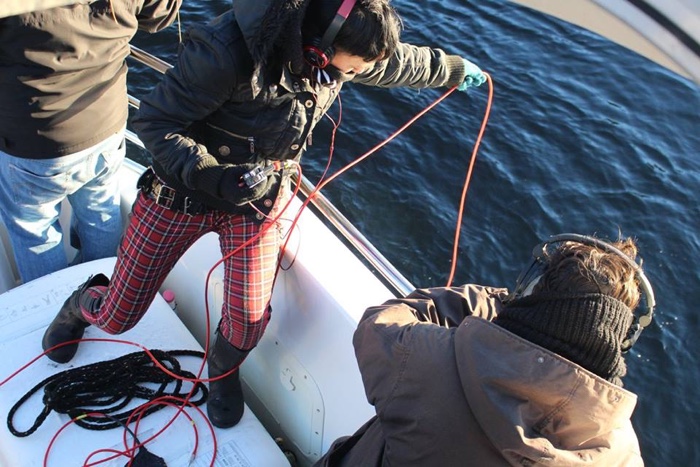
Field trip of hydrophone recording during the workshop Pikslo deep diving at Piksel festival, Bergen 2015
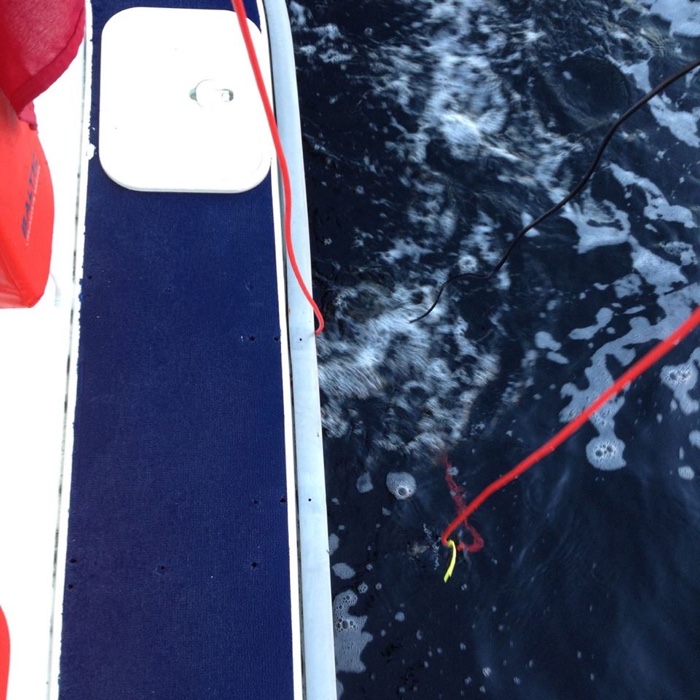
Field trip of hydrophone recording during the workshop Pikslo deep diving at Piksel festival, Bergen 2015
During the recording sessions and field trips, I was surprised again and again by how omnipresent the noise produced by man-made technology is in the sea. Motors boats, ships, sonars and oil platforms are crucially shaping and rapidly changing the soundscapes of the oceans because the quantity of marine traffic (more than) doubled in the past fifty years. Moreover, increased use of sound cannons (used for oil exploration) also creates huge disturbances in fragile marine habitats.
These aggressive soundscapes have led to a number of consequences such as the beaching of whales and the Lombard effect where some species become louder to overcome background noise, thereby gradually increasing sound intensity in the entire habitat. There have been many studies and initiatives that try to point out these issues and invite us to rethink the nature of humankind’s industrial endeavour.
The technology that people use in marine habitats is certainly invasive and I deeply hope that the future development will be more oriented towards less invasive technological equipment for travelling or for using the world’s oceans and seas.
Robertina Šebjanič, Aquatocene / Subaquatic quest for serenity
Could you tell us about the instruments you used to pick up those (under)water sonic environments?
I mostly use hydrophones and preamplifiers, be it professional equipment or my own, self-produced, DIY hydrophones. So my practice ranges from building equipment, to recording underwater sounds, to conducting workshops. I believe that with this kind of personal touch, having small groups during workshops, it is possible to bring pressing issues of ecology closer to the public.

Field trip of hydrophone recording at micro-residency at Grey) (Zone gallery at Korčula Island in Croatia

Field trip of hydrophone recording at micro-residency with Annick Bureaud and Darko Fritz at Grey) (Zone gallery at Korčula Island in Croatia
The work is titled Aquatocene which of course made me think of ‘anthropocene’. Could you explain the rationale behind this title Aquatocene? And what is the influence of man on this (under)water sonic environments?
The name Aquatocene is a direct paraphrase of the term Anthropocene (as is lately referred to the geological stage of our planet). The full title of the work is Aquatocene / Subaquatic Quest for the Serenity; however, with this project I do not try to illuminate the main issue of the impossible quest on how to find a sound free environment for the marine life. The name was also inspired by Donna Haraway’s latest book, where she writes about Chthulucene and Capitalocene, by the texts of Timothy Morton, and by some other contemporary writers as well as colleagues from the art & science scene.
During the presentation of Aquatocene (as a performance or installation; the project has various possibilities of presentation), the audience is immersed into soundscapes which are a mixture of diverse materials I recorded in specific marine locations. These are therefore my interpretations of sonic environments – the way that I experience them on specific locations. The final sound compositions are locative and time-determined situations that are reflecting everyday situations in particular locations. The compositions are mixture of animal sounds, water currents and noise of human interventions.
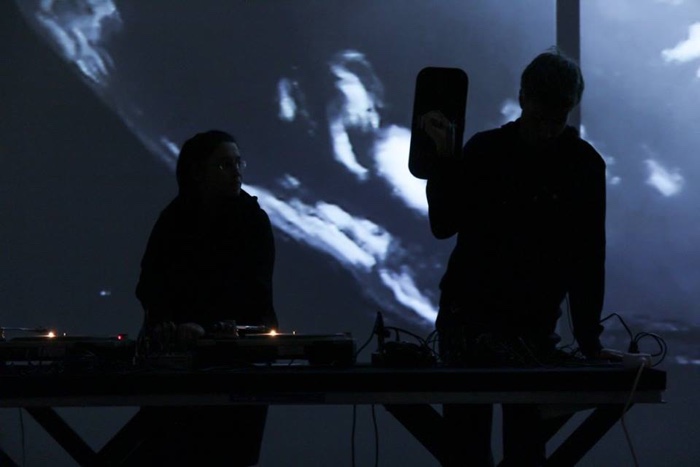
Robertina Šebjanič, Aquatocene / Subaquatic Quest for Serenity. Performance at Kiblix festival, with invited guest Miha Ciglar and Acouspade™Directional Speaker. Photo by Kibla
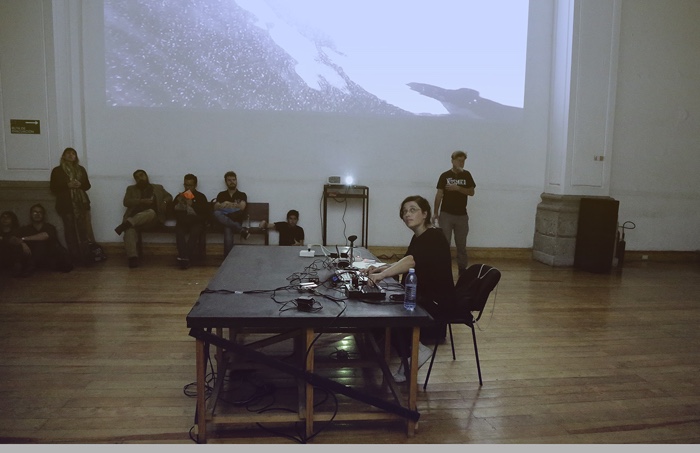
Robertina Šebjanič, Aquatocene / Subaquatic Quest for Serenity, audiovisual performance and lecture by Robertina Šebjanič at Kosmica festival, at Laboratorio Arte Alameda at Mexico City. Photo by Kosmica archive
The human impact is enormous. It is the direct consequence of huge production and consumption, in the industries such as fishery, marine farming, oil platforms, and marine traffic. I believe that now is a good moment for a profound introspection that would eventually lead to environmentally friendlier marine technologies; because the huge environmental problems that humankind is facing nowadays are complex combinations of socio-political, economic and scientific developments.
Your project Aurelia 1+Hz/ proto viva generator “addresses possible coexistence of humans, animals and machines.” Aren’t we, humans, already cohabiting with machines and animals? What does your project bring to this coexistence between different species and entities? How different could this coexistence be be from what is already out there?
Before I start talking more specifically about Aurelia 1+Hz / proto viva generator I would like to point out that the project, which has been in development for 5 years consists of two parts; the performance Aurelia 1+Hz / proto viva sonification (2015) looks into a new critical redefinition of social values and new attitude towards interspecies cohabitation and is presented as a audio-visual performative act, where I perform together with moon jellyfish; the installation Aurelia 1+Hz / proto viva generator (2014) on the other hand deals with bio-policy of prolonging human life and with the relationship between man and animal.
Robertina Šebjanič, Aurelia 1+Hz – video with voice over
As we are ever more surrounded (and also enhanced) by technology, it gradually becomes so ubiquitous that its presence becomes normalised to us. The work Aurelia 1+Hz / proto viva generator, addresses the coexistence of human animals and machines in this “new normal” situation and raises a number of questions such as what kind of future scenarios are awaiting us in the fields of medicine, in particular prolonging our life span with the use of the biotechnological inventions.
The project uses living organisms to process “aliveness” of a simple robotic machine or better said mechatron. In the installation, the two entities – jellyfish and robot – are physically separated and there is a strong digital dependency between them.
Improved living conditions in a technologically advanced world enables us to live significantly longer than in the past centuries. But the question is how this coexistence and relationship is going to be shaped in the future?
Nowadays there are double moral standards regarding the animals when we are thinking and talking about their rights. The species / organisms which are used by humans for purpose of hyper industrialisation and for our consumption are not treated in the same way as the ones that we have chosen to be our pets. I could claim that we co-evolved with them as for instance with dogs and cats.
Robertina Šebjanič, Aurelia 1+Hz / proto viva generator. Installation at kapelica gallery
With the progress of biotechnology we manage to prolong our life expectancy and we are constantly aware of the properties of organisms that have adapted during the evolution process. For instance jellyfish is used as a model organism in biology and science to explore their regenerative possibilities (Hydras and Axolotls are also used for this purposes).
This kind of knowledge could enrich our bodies, help us heal disabilities and also help us live longer and more prosperous life. But there is another side to it: how long is long enough? The answers to this question appear to be in the hands of the cosmetic and pharmaceutical industries which use their (bio)political power and their capital to divide societies into those who are able to prolong their life, and those who are merely trying to survive. Today, the historical tactics to ensure our cultural immortality are contrasted with biotechnological possibilities of actually designing and controlling life. There is a need and demand for new critical redefinition of social values.

Robertina Šebjanič, Aurelia 1+Hz. Photo by Hana Josic
The work features jellyfish. What have you learnt from working with these aquatic animals?
Engaging with different biological entities always inspires me. I think it is very rewarding to get to know another species that lives in totally different habitat than I do, for instance. By observing and following jellyfish in the sea, I started to understand better the complexity of water habitats, as well as their behaviour. Seas and oceans are huge territories that are still not sufficiently researched and I hope that our relations towards this issue will change in the future. With jellyfish I got closer to researching complex ecological situations that are occurring in the oceans and seas. Phenomena such as microplastic, sonic pollution, warming up of the oceans is happening here and now, thus it is not something that might occur in the future.

Robertina Šebjanič, Aurelia 1+Hz / proto viva generator. Photo by Miha Fras

Robertina Šebjanič, Aurelia 1+Hz / proto viva generator. Photo by Miha Fras
I’m really intrigued by the robot in the installation. It doesn’t look like your typical robot. What guided its appearance? What does it do exactly? How does the machine ‘relate’ and ‘interact’ with the jellyfish?
The “robot” is basically a mechatronic sculpture, a simple working machine that is moving in correlation with the movement of the jellyfish; if the jellyfish stops moving, the robot doesn’t work. The movement of the jellyfish is recorded in real time and is then translated into the movement of the machine. The installation is presented in a dark space – where these two entities – jellyfish (in aquariums) and machine (in a glass tube) coexist.
Cohabitation – or coexistence or living next to / with each other could be a good brief description for a number of my works. One of the books to which I refer very often is A Foray Into the Worlds of Animals and Humans by Jakob von Uexküll, a theoretical biologist from the early 20th century, who was working extensively on animal behaviour studies and on the cybernetics of living systems. His theory about the Umwelt largely inspires my work.

Schematic view of a cycle as an early biocyberneticist // Uexküll’s wirkkreis (it’s a great description and was also inspiration for the schematic of the installation)
Have you noticed if the jellyfish are disturbed or otherwise affected in any way by the performance?
Before starting to exhibit jellyfish I managed to learn a lot about them and also I had them at home as pets. During exhibitions that include jellyfish, my main concern is to provide the best possible environments for these animals. The aquariums I use for that purpose are specially developed for jellyfish. One of the challenges of the project was to bring pretty “unknown” species of jellyfish closer to the public, in a way that would feel natural but still maintain firm artistic and scientific interpretation; however, it is surely not about the spectacle of displaying an animal in the aquarium in a gallery setting. The main question that I have been raising is: what is the new reality of nature – culture // human – animal?
Jellyfish is one of the ancient species that have been around for more the 500 million years and are in my opinion a great evolutionary archive – they are a memory of the past and indicators of the future. Even though the environment of the oceans and seas has been changing rapidly lately, mainly because of the human imprint, it seems that it does not disturb them. They can adapt to more acidic, less oxygen-rich environment and survive, unlike numbers of other species such as corals, fish (mostly because of overfishing) whose numbers are rapidly shrinking.
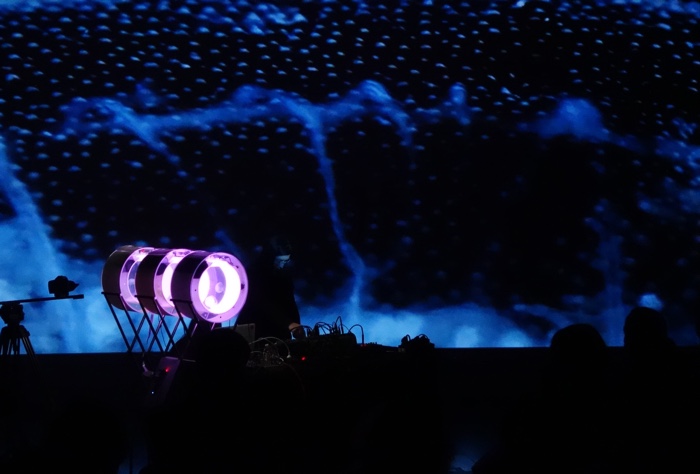
Robertina Šebjanič, Aurelia 1+Hz / proto viva sonification. Photo by Le Cube
The performance features live transmitted sound generated by Aurelia Aurita jellyfish. Could you tell us about the sound emitted by the jellyfish? What kind of sounds are they and how are they captured and made audible?
As I mentioned the Aurelia 1+Hz project has two phases – Aurelia 1+Hz / proto viva generator is presented as an installation with two entities: jellyfish and machine; and the second part of the project, Aurelia 1+Hz / proto viva sonification was developed as an audiovisual performance where jellyfish and myself are the only two entities present. I like to use a quote of the poet Paul Celan in order to briefly explain the project: “There are still songs to sing beyond mankind”. The central idea of the project is that there is not only human civilisation living on our planet but there are also other species (animals, plants, fungi, bacteria, etc.) with complex and highly developed communication systems which are basically their languages.
The sound used in the performance consist of recordings from the sea (sound recordings of the jellyfish blooms) and the experiments in the laboratory (recordings of sonification of their movements). Most of the sound recordings were done during my residency at the Izmir marine station with sonic, seismic devices and hydrophones. There are different categories of sounds that are then performed in the audiovisual performance.
Moon jellyfish is a model organism in biology and therefore it has been researched extensively over the past few years. My aim was to find out how they communicate. It has been discovered that they communicate with each other using polyps and their chemical components. The rudimentary sensory nerves at the base of their tentacles are perceiving light, smell and orientation. However, it is still unknown how complex their communication system actually is.
Robertina Šebjanič, Aurelia 1+Hz / proto viva sonification, a 3 min video extract of the performance at Le Cube
You’ve worked with the Institute of Marine Science and Technologies in Izmir and with other research centres. How do you, as an artist, relate and dialogue with scientists?
Working on research and combining different disciplines can be very demanding as each of these disciplines demands a different approach regarding the way to work and the kind of environment needed for research and development. Each of my projects is very specific and the hardest thing is to figure out basic parameters even before the research process starts. When the methodology of the research is clear, nearly half of the work is done.
I think that personal relationships, similar interests and passion for specific topics are key attributes needed for the success of the collaboration in the field of art & science. I have visited and worked with different institutes, in the framework of residencies, and what I learned is that it takes time to get to know each other and the topic of research. Also there has to be mental and intellectual transfer happening on both sides because if any of these key components is missing, it becomes very hard to work together.
For each project there are of course different ways of how to make it happen. Work in Izmir marine station was a very strong experience. The collaboration was conducted by curator Saša Nabergoj, who included different working groups to the concept of the Triennial of Arts. Together with Assoc. Prof. Dr. Guzel Yucel Gier and Betül Bardakcı from the marine institute we started that model. But I was not so unfamiliar with these issues and i got help from a great consultant – globally acclaimed plankton specialist Dr. Alenka Malej from Slovenia.
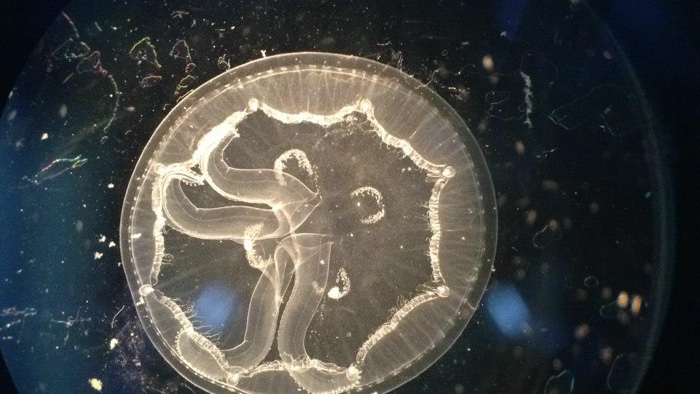
Deep Blue, field work and research at Institute of Marine science and technologies, Izmir, Turkey
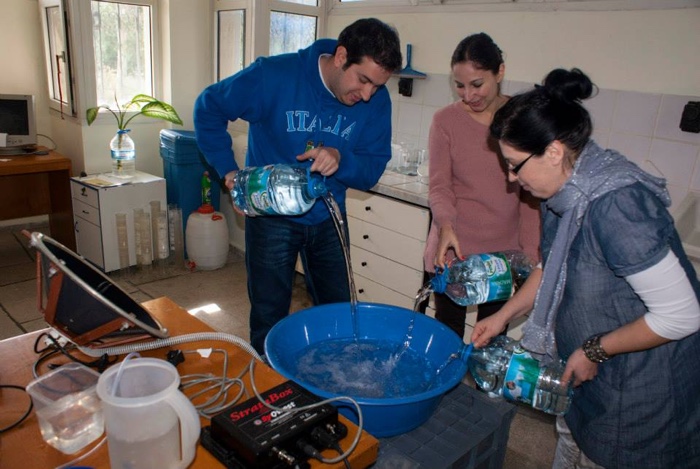
Deep Blue, field work and research at Institute of Marine science and technologies, Izmir, Turkey
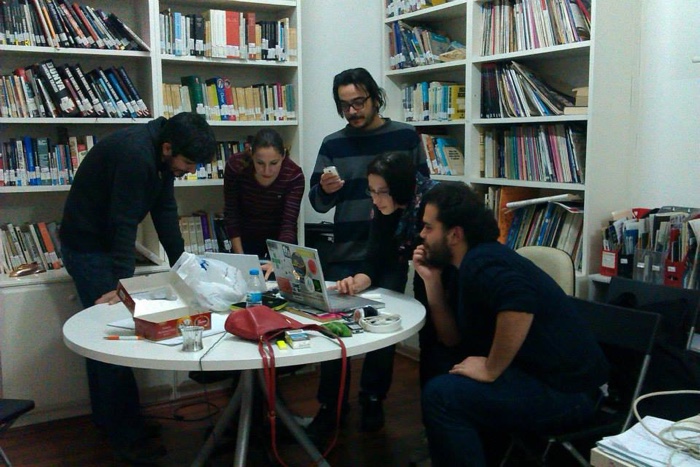
Deep Blue, field work and research at Institute of Marine science and technologies, Izmir, Turkey
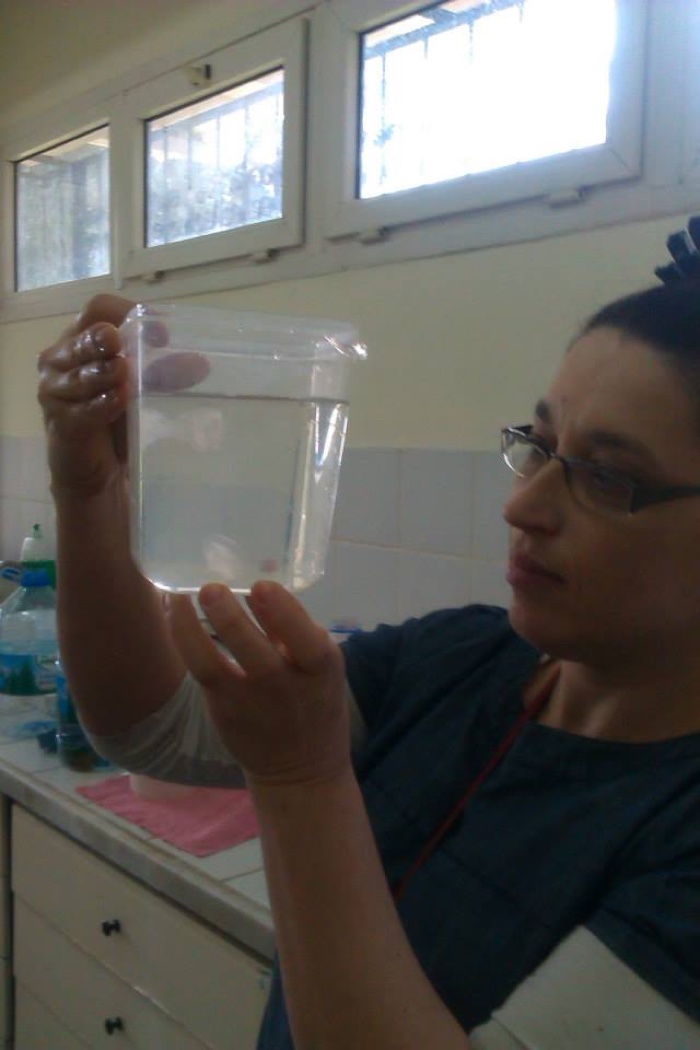
Deep Blue, field work and research at Institute of Marine science and technologies, Izmir, Turkey
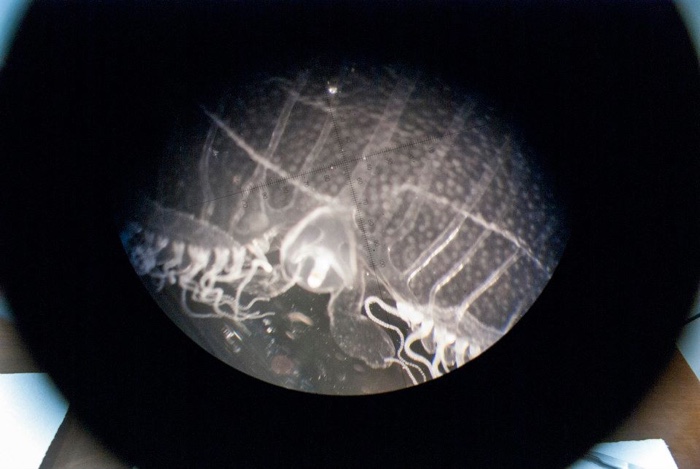
Deep Blue, field work and research at Institute of Marine science and technologies, Izmir, Turkey
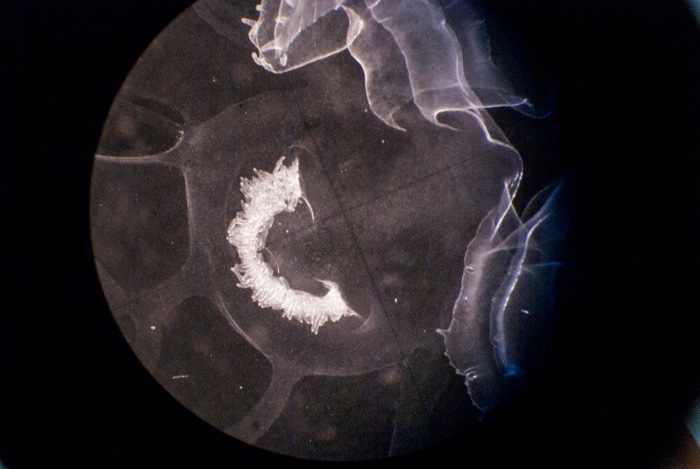
Deep Blue, field work and research at Institute of Marine science and technologies, Izmir, Turkey
I always mention the names of collaborators because it is important to explain how complex this kind of interdisciplinary collaborative projects are and that there are always many people involved. And I think I shall not forget to mention also the people and institutions that enabled the project. Aurelia 1+Hz / porto viva generator was supported and premiered at Kapelica Gallery in Ljubljana. The performance Aurelia 1+Hz / proto viva sonification was supported and presented by Decalab and Le Cube in Paris, and I had a great support in consultancy by Annick Bureaud, who later also helped me to conceptually frame the Aqautocene project.
Also it was a great experience last year to attend a residency at Roscoff Marine biology institute, which was made possible by curator Ewen Chardronnet; he cultivates an ongoing friendship with one of the leading scientists, Dr. Xavier Bailly, and with the support of the institution Ping from Nantes, they established artist in residency programmes at the marine institute in Roscoff. I think that the field is getting stronger from year to year and that there is a big push from different art & science educational, research and artistic programmes such as festivals Ars Electronica and Arts at Cern. That merging of different fields of expertise will get stronger and more articulated in my work, also because of the experiences in the Hackteria network.
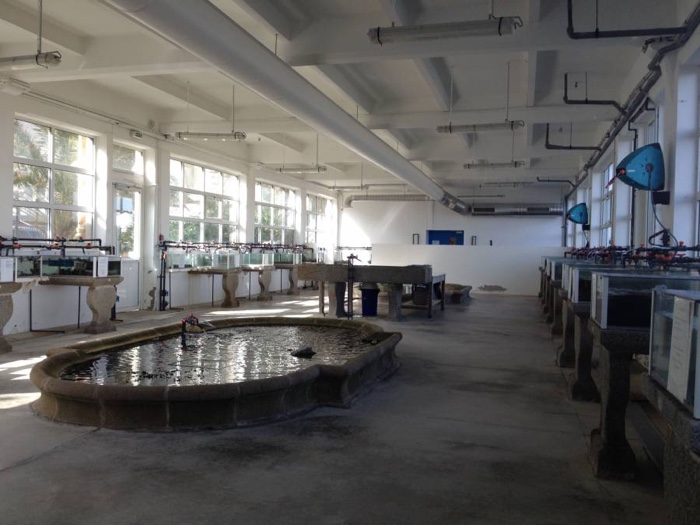
Aquarium facilities, at Station Biologique de Roscoff / CNRS - UPMC
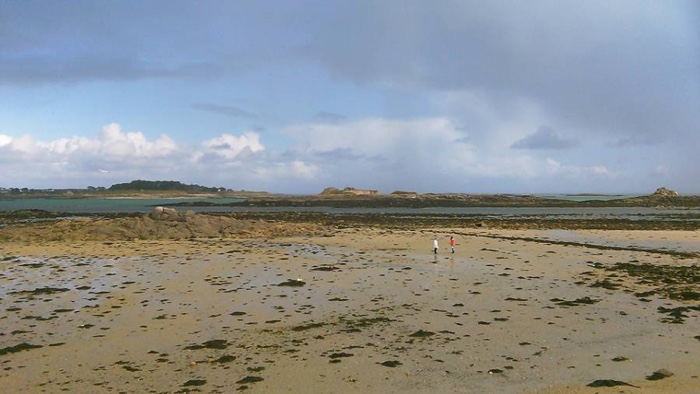
Field trip at residency at Station Biologique de Roscoff / CNRS - UPMC
Self-initiated communities, either formal or informal, play an important role in this field. While answering the questions for this interview, I was in Mexico City to work on the research of a new project Lygophilia / Transfixed gaze and I am pleased to be an artist / researcher in residence at Arte+Ciencia at UNAM University, where they can help me in many useful ways. I am working on a concept of “charismatic animals” and one of those is undoubtedly Axolotl – the Mexican salamander that could be found in nature only in the lakes of Mexico. However, it is a very common animal in laboratories around the globe. I try to navigate the storytelling about these conflicting realities as artist and researcher at the same time. I find a great collaborators at UNAM department of biomedicine, at CIBAC from UAMX, at UNAM ecology research department and many more individuals and groups and institutions that are working with the animal and ecological issues that are surrounding it. The residency offers a great community of philosophers, scientists and artists, and I think this is the perfect environment to work on the project that will soon be premiered during Transitio Mx festival in Mexico*.
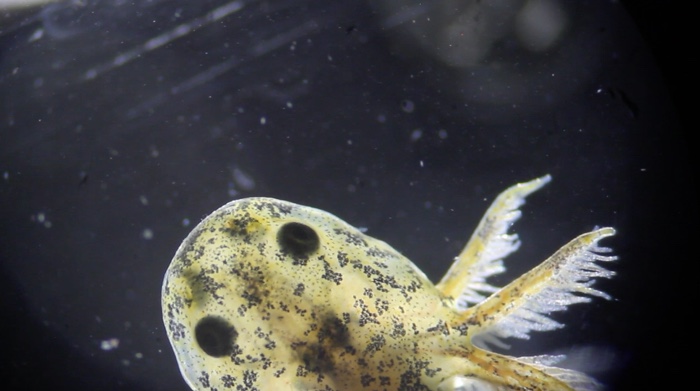
Art research project Lygophilia field trip with team of at CIBAC from UAMX and Arte+Ciencia at UNAM, Mexico City
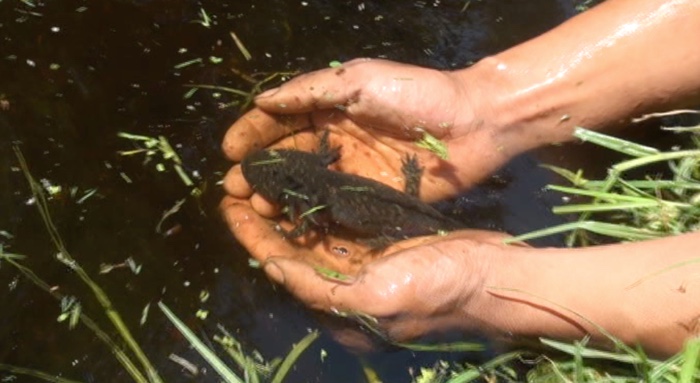
Art research project Lygophilia field trip with team of at CIBAC from UAMX and Arte+Ciencia at UNAM, Mexico City
How can artist contribute to improve the relationship we have with the rest of the world and in particular with non-human animals?
It is difficult to say who and what has a real impact in the world as cultural imperatives change from continent to continent which symbolises the relationship between culture and nature. But art is definitely a good platform to educate, raise awareness and (maybe eventually) to make change. In this instance, it does not matter if the works of art focus on small, only locally significant issues, or if the art works have a greater impact which resonates over cultural, geographic and time barriers.
The relationship with animals and in general with all living systems is complex and there is still a lot to be observed and researched. We live in a world where relationship of local – social – economic conditions are still presenting a big difference between the cultures, consequently, it also reflects on the relation to nature. The beauty of the diversity of cultural heritage, that is still present, is important to maintain and the power of nature is stronger than we think, as sometimes we start to be blinded by the (bio)tech advantages (from biomedicine, space flights, geoengineering, etc..) that we invented and the knowledge we have, that we forget to take care of the nature that is surrounding us, and that taking care of nature is also nourishing our culture on the planet we live.
Thanks Robertina!
All images courtesy of Robertina Šebjanič.
*due the tragic events of the strong earthquake on the 19 September 2017 in Mexico, the festival Transitio Mx festival was canceled and the presentation of the new work has been postponed.
